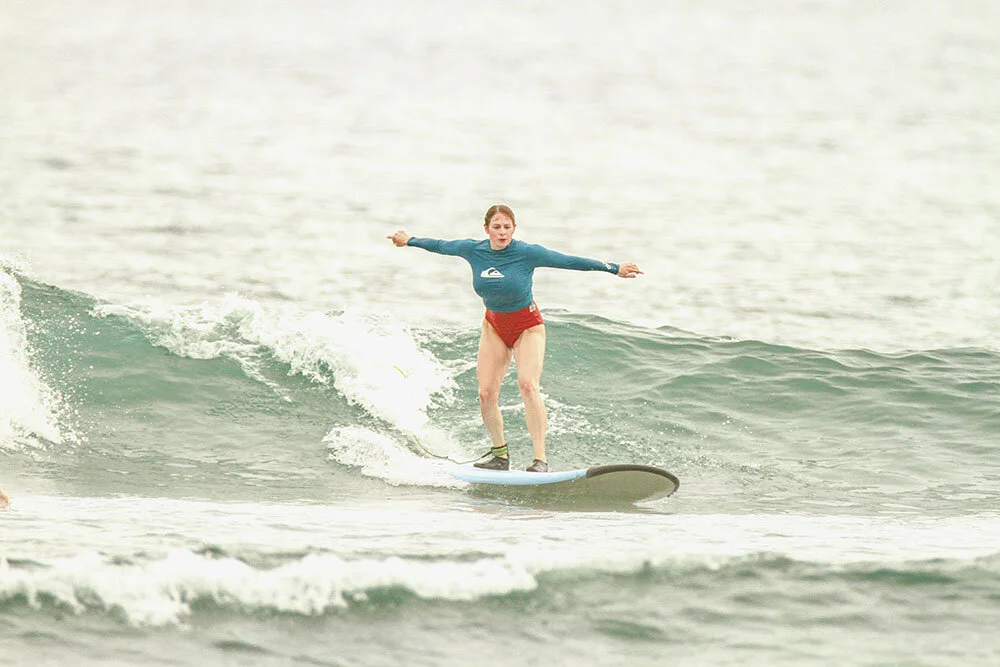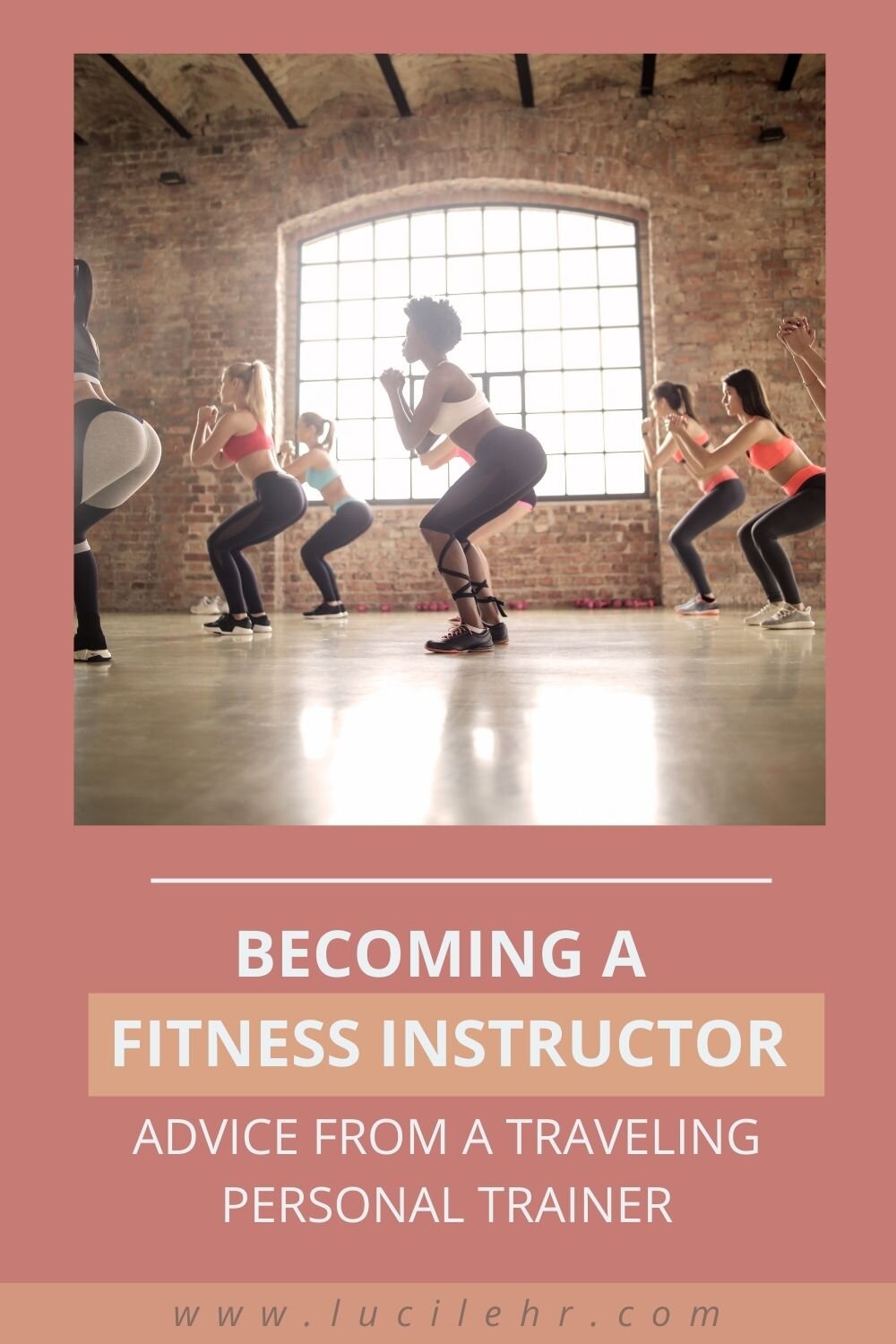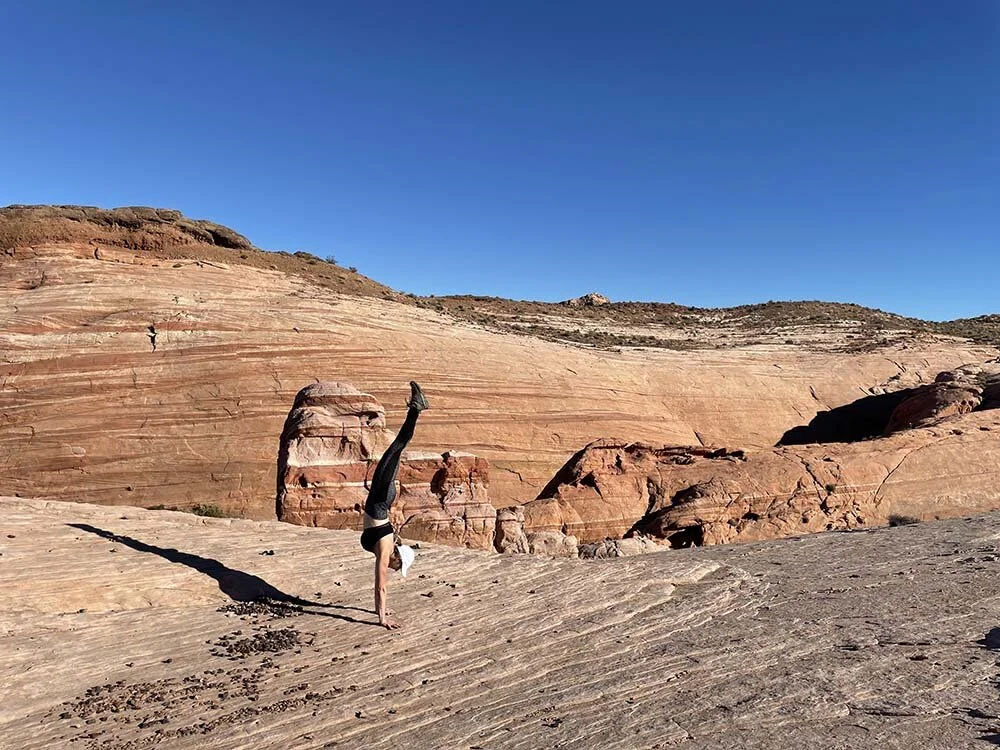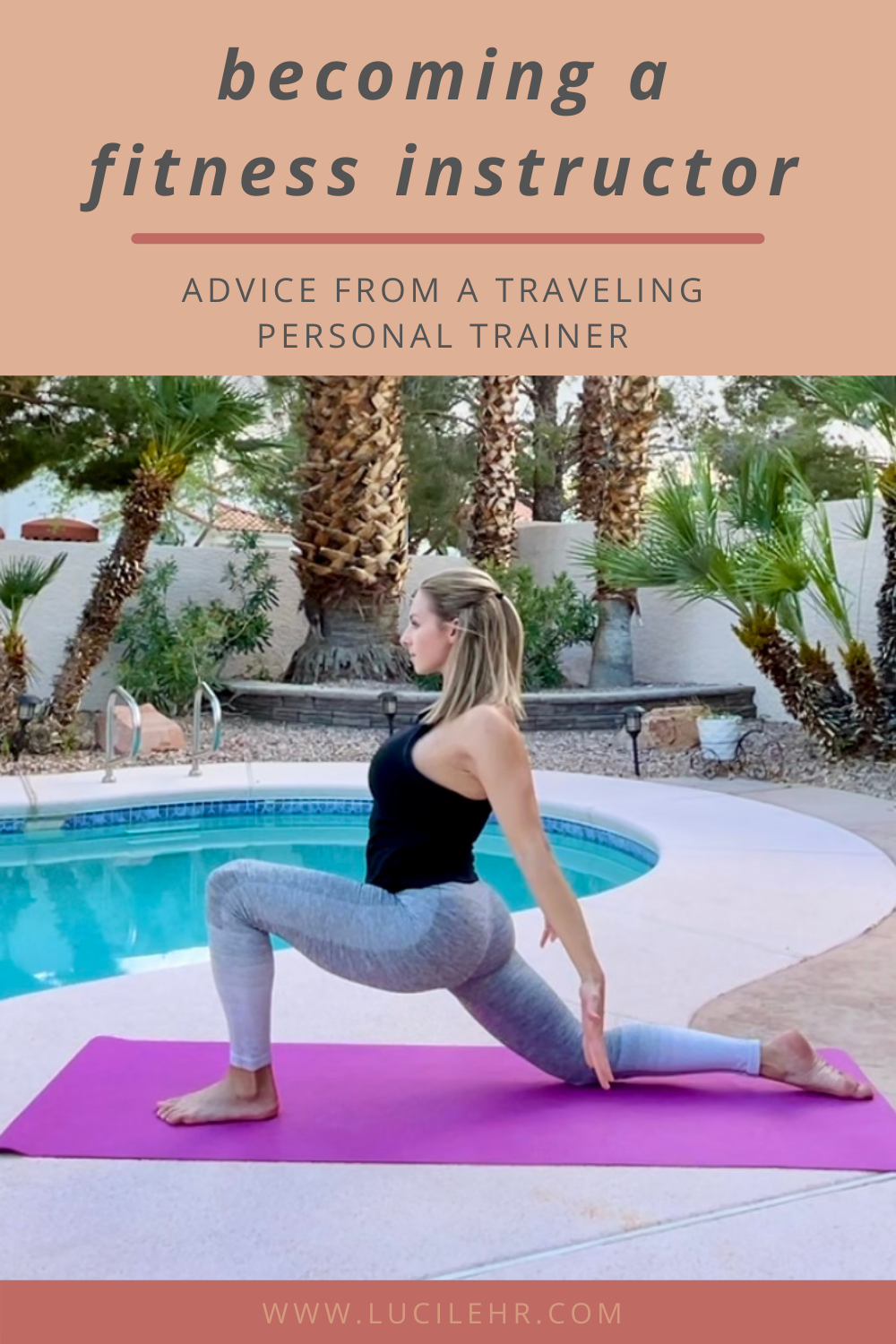Becoming a Fitness Instructor: Advice from a Traveling Personal Trainer
Kylie is the fitness blogger behind Catch the Drift and traveling personal trainer. I am so happy to bring her advice and unique story to the blog. As a military spouse, she has lived and worked in many countries before moving most of her business online. Her story has been so inspiring to me as finding balance between your passions and travel can sometimes be tough!
You’ll love all her tips coming from years of experience about becoming a fitness instructor or personal trainer, how to find your niche, your first jobs, and overall create a fitness career you’ll love!
My fitness instructor journey
Moving abroad made me rethink my career
I became a fitness instructor right after I married my husband and moved to Italy. Living in a foreign country as a military spouse was an amazing experience, but made it extremely difficult to find a career.
With health and fitness always being a passion of mine, I decided being a fitness instructor could be a job I could take with me wherever I was living. So, I studied to become a personal trainer through NASM and obtained my certification a few months later.
Finding a job was much more difficult that I had imagined
It wasn’t until I started searching for jobs that I realized this was going to be way more difficult than I had anticipated.
In Italy, the only gym I could work for was the gym on base. Unfortunately, the gym was not hiring any personal trainers at the time. This was fine though, because we were moving to Las Vegas in a few months. During this time, I trained a few friends for free just to practice my skills.
When we arrived in Las Vegas, I began applying for jobs again with gyms in the area. The only problem this time was that we would only be living there for six months. I made the mistake of being honest about this with the gyms I applied for, and none of them were interested in wasting their time to hire someone who would be leaving so soon.
Taking unpaid jobs to get more experience
Six months later, we were moving to South Korea for a year. The very first week we arrived, I made my way over to the gym to inquire about training positions. Unfortunately, they were not hiring for personal trainers, but were looking for group fitness instructors to volunteer to teach classes a few times per week.
Without many options to train elsewhere, I chose to volunteer for the group fitness instructor position (even though I had never taught a class in my life!).
The gym was fine that I didn’t have a certification specifically for teaching group fitness, but really just cared that I had my personal training and CPR/AED certifications. (I later obtained my group fitness certification through AFAA).
I taught classes the entirety of my time in South Korea and also picked up a few freelance personal training gigs through building relationships with the students in my classes.
Transitioning online
Getting frustrated that I would have to keep starting fresh every time I moved, I decided to take my business online. At about the same time, it clicked to me that a lot of travelers had problems staying fit and healthy while traveling around the world. This community, similar to my situation, also could not be in one place to join a gym and work out consistently.
Finding my ideal clients
I utilized my travel blog to pivot into this sub-niche of fitness travel.
What is fitness travel?
Fitness travel is essentially adding fitness into a traveler’s lifestyle. I wanted to inspire other travelers to make the time and effort to put their health and fitness first, regardless of where they were.
What types of traveling fitness jobs are out there?
Honestly, traveling fitness jobs in this current day in age primarily consist of working as a virtual fitness instructor or working at a physical fitness company, such as a retreat center.
Looking to be a little more unique within this industry, I began creating different methods of ways travelers could workout without needing any required equipment in a gym setting.
How do you become a traveling fitness instructor?
Today, without any additional certifications, I pivoted my business into helping travelers determine different workout methods that work with where they are in the world. It’s primarily what audience I am targeting my business towards.
Whether this be making a hotel room workout, an active scavenger hunt around the destination they’re visiting or finding local workout classes that can immerse them in a different culture while getting their workout in for the day.
Your health and fitness are so incredibly important, but I totally get how important travel is too (as I am just as obsessed with the nomadic lifestyle myself). Combining these two things is an easy task that really won’t take away from your wanderlust.
In the future, I hope to organize health and wellness-centered retreats to show travelers just how enriching it is to be immersed in self-care in different parts of the world.
How to become a certified fitness instructor
Becoming a fitness instructor goes far beyond simply knowing how to instruct a workout session, or being fit yourself. Of course, these are important factors, but there is much more to the job.
Know what kind of fitness instructor you are interested in becoming
First off, I’ll clarify the difference between a personal trainer, fitness instructor, and group fitness instructor.
A personal trainer and a group fitness instructor could technically both label themselves as a fitness instructor. Though, note that a group fitness instructor may not always be certified as a personal trainer. Both require separate certifications.
Group Fitness Instructor
As a group fitness instructor, you will be teaching larger group classes a specific workout routine in a variety of formats: cycling, circuit training, Tabata, boot camp, yoga, Pilates, stretching & flexibility, and more. Most instructors choose one or two formats to focus on, depending on their personal strengths and interests.
A big difference between a group fitness instructor and a personal trainer is the type of interaction you get with your clients.
Personal Trainer
As a personal trainer, you will be working directly with a variety of different clients either one-on-one or in a small group setting. Since you will be implementing a customized workout routine into their daily lives, you must get to know all of the ins and outs of your client.
Here is an example of a personal trainer’s responsibilities:
Imagine a new or potential client comes up to you and says that they want you to train them. You provide them with a questionnaire to get to know more about them and their lifestyle, as well as to ensure they are healthy enough to exercise.
Get to know your client
In the questionnaire, you discover that there are a few main drivers of wanting to implement a workout routine into their life. As they’ve gotten older, they’ve gained a few extra pounds, they’re lacking some confidence in themselves, and their doctor threatened to put them on medication for hypertension if they don’t change their habits within the next few months.
Be aware of any health conditions
A fitness instructor needs to be able to pick up on that cue that they have a health condition – hypertension. Although, their doctor recommended your new client starts a workout plan, you need to be able to create a specific program for their needs. Your workouts cannot be one-size-fits-all.
In this scenario, you’ll have to remember that clients with hypertension should not be doing any exercises lying on their back or stomach, they should avoid any heavy lifting, and avoid high-intensity exercises. When creating their program, you’ll also want to alternate between upper and lower body exercises to help distribute blood flow throughout the body.
Set goals and motivate
Apart from the health-related drivers for your client wanting to start a training program, you need to help your client implement specific goals for them to work towards. The goal should be something that can be measured over time in order to track progress and see results.
With knowing your client’s goal(s), you need to also take into account for what types of exercises and workouts your client enjoys. If you are creating a program with exercises that don’t interest your client, their motivation to keep working out will plummet. Honest communication is absolute key.
Get personal
On top of all of that, it is a good idea to know more about your client’s every day life. Are they married? Do they have kids? What is their profession? How many hours do they typically work? What kind of hobbies do they enjoy?
Utilizing all of this information will not only help with creating a customized program for your client, but it will build a ton of trust when they can see that you are taking their daily lives into account.
Helpful things to know when looking to become a personal trainer or fitness instructor
Getting back to the process of becoming a fitness instructor – the above example demonstrates just a handful of things that a fitness instructor must learn in order to become a certified personal trainer.
Study, study, study!
There are multiple programs that one can enroll in to become a a fitness instructor. This will mainly consist of studying a textbook, watching videos, and taking quizzes to ensure that you are knowledgeable in everything from general kinesiology to different exercises you can implement into a client’s routine.
After you feel confident with the textbook material, you can register to take your final exam, which will provide you with your certification upon passing.
Know your muscles
I found that the most difficult part of the studying for the exam was getting super familiar with each and every muscle. If a client’s knees are moving inward during a squat exercise, or if their head protrudes forward due to sitting at a desk all day, you must know exactly which muscles you need to work on strengthening and which muscles you should be stretching in order to balance their muscles and prevent injury.
Getting familiar with how your own body moves is extremely helpful. Physically feeling with your hands the different muscles that are working when you move certain parts of your body can really help you to understand not only the muscular system, but also what different exercises work the different muscles.
Have the right personality
On top of textbook knowledge, a fitness instructor must have a friendly and approachable demeanor. Many clients who are seeking out help with their fitness routine often are lacking a little confidence or self-esteem. As a fitness instructor, you need to be someone that they can trust and rely on to help them reach their goals.
Sell yourself
Same goes for those who are not clients. Only part of being a fitness instructor is helping people to workout. The other part is selling yourself and selling why you could help someone reach their goals.
How to become a personal trainer online
Today, especially after the pandemic, becoming a personal trainer online is becoming more and more common.
Luckily, many organizations are allowing trainers to take their exams virtually, allowing much more freedom for anyone interested in pursuing this career.
Upon passing your exam, you can find jobs simply by searching ‘online personal training jobs’. Many companies today are looking to hire virtual personal trainers so clients can workout in the comfort of their own space, regardless of where they are.
If working for a company is not your goal, you can also start your own personal training business online.
For me, I started with a blog and some YouTube videos. I mainly find my clients, though, through word of mouth.
Helpful things to know when looking to become a group fitness instructor
The process of becoming a group fitness instructor is a little easier than becoming a personal trainer. You still need to have a general understanding of different health conditions, but since you are not creating personalized workouts for each individual in your class, the information is a little more broad.
Understand different class formats and what your niche will be
If you add on a group fitness instructor certification to your personal training certification, the studying is very simple as the required knowledge overlaps. The additional things you will learn are different techniques to teach classes and the difference between the various class formats.
You’ll want to choose your niche based on your strengths and what you enjoy doing.
Have the right personality
Although you may nail the textbook information, you also must have a very motivating, energetic, and friendly personality to do well as a group fitness instructor. Since you cannot give individualized attention to each attendee in your class, you need to focus on different ways you can accommodate all levels (unless it is a class with a specified fitness level).
CPR/AED Certification
In addition to both a group fitness instructor certification and personal trainer certification, you will be required to obtain a CPR/AED certification. This can typically be done in one in-person class, where you will learn how to perform CPR and use an AED.
Continuing Education
Note that once you obtain a group fitness instructor certification or personal trainer certification, you will need to continue to take classes or attend trainings to keep up with continuing education credits, which will keep you certified.
What is the best personal training certification?
This really depends on where you would like to work one day. If there is a specific gym that you want to be a personal trainer for, it is a good idea to check out that gym’s certification requirements.
Some gyms only accept one or two certifications, whereas other gyms may provide their very own certification training program, in which case you wouldn’t want to waste your time and money on a different program.
Two of the most-reputable certifications are through NASM (National Academy of Sports Medicine), or ACE (American Council on Exercise). You’ll find that a good handful of gyms accept these certifications for personal trainers that they hire.
If you are not planning on working in a commercial gym, you’ve got a little bit more freedom as to which certification you choose. Granted, if you are trying to freelance, it is a good idea to choose a well-recognized certification to portray to your clients a sense of credibility, especially if you are just getting started.
What is the best group fitness instructor certification?
There are multiple organizations where you can get a group fitness certification. The most well-recognized organizations are AFAA (Athletics and Fitness Association of America), ACE (American Council on Exercise), and NETA (National Exercise Trainers Association).
Take a look at the gyms where you would like to work and see what type of certifications they accept. If you are unsure of where you may end up working, I’d suggest going with one of the top few organizations, which are most commonly known amongst most gyms.
How much do personal trainers make?
This varies significantly based on what kind of personal trainer you are.
If you work for a commercial gym, you will be only getting a cut of how much your session costs. The session cost is primarily determined on how much experience you have.
If you work independently, you can charge whatever you would like.
On average, a personal trainer will charge between $40-$70 per hour session.
How much do group fitness instructors make?
Depending on the gym, most group fitness instructors make $23-$25 per hour class.
The pros and cons of being a fitness instructor
Like any job, being a fitness instructor will definitely have its pros and cons. Really looking at what matters most to you will help you to determine if this is the right career path for you.
Cons:
Since a fitness instructor is primarily a commission-based job, meaning that you only get paid when you have a client, it can be a tedious industry to get into not knowing what your yearly salary will look like.
If you work for a commercial gym, expect to only get a cut of what you are charging your client. For instance, if you charge your client $50 per hour, you may only take home $25 of that. This is where freelancing can be beneficial. You won’t have as much exposure as in a commercial gym, but at least you can set your prices and keep everything you’ve earned.
A good chunk of the job is sales – building relationships with current clients (basically proving your worth), and making new relationships to find new clients. This can be tough to do both in a commercial gym and as a freelancer. This is the primary way you are going to get business.
In commercial gyms, you may be required to work long hours (think 6 AM shifts and staying until your 7pm client leaves). Many gyms also require trainers to work at least one weekend day, making it a 6-day work week.
If you do not find and train enough clients in a given amount of time, this could be a deal-breaker between you and the commercial gym you work at.
Once you get your fitness instructor certificate, you need to continue to invest in your training business through continuing education credits to stay certified. This usually can cost a good chunk of money every two years or so.
If working for yourself as a freelancer, you will have to purchase general liability insurance.
Pros:
Since you are commission-based, there is no cap for how much money you can make. It all depends on how many clients you can get.
If you work for a commercial gym, many gyms will pay for your continuing education credits to keep you certified.
If working out and helping others is something that you love, there are so many benefits to this job. Especially hearing that your clients are seeing results is such a rewarding feeling.
If working as an online personal trainer, this job can go with you wherever you are.
If you work for a commercial gym, you will receive a free gym membership and other perks.
You get paid to talk to some really cool people and help them achieve their goals.
Health Coach vs Personal Trainer: which one is for you?
If you love helping people accomplish their wellness goals and feel better, these are two great career choices for you! You could totally do both as they are very complementary.
With Health Coaching, you learn the skills to help people feel good in all areas of their lives from sleep, to food or even relationships. If you want to learn more about this career path, check out this article or even this sample class from IIN, the leading health coach certification.
Tips for new personal trainers
Starting out as a new personal trainer can sometimes feel discouraging. Be confident in your skills – brush up on them if they are lacking – and really sell yourself.
Show others why you would be a perfect trainer for them and how you can help them reach their goals.
Really be passionate about helping others achieve their goals. It will be so fulfilling when you hear your client say that they are seeing results.
Remember to workout yourself! If you don’t practice what you teach, why would a client trust you to help them?
Final words from Lucile + connect with Kylie
I hope you enjoyed this article as much as I did! This was super informative and inspiring, and I always love a good “follow your dreams” story! If you’re here thinking about how to start your dream career or even how to combine it with your other passions or even love, Kylie’s story showed you that everything is possible!
If you want to connect with Kylie, you should definitely check out her Instagram, or even work on your fitness goals with her!
Bio:
Kylie Loyd is a military spouse who has pivoted her personal training business to focus on training and encouraging travelers to stay fit and healthy while on the go. Kylie offers virtual and in-person training, written workout plans, group classes, and more to accommodate traveler’s health and fitness needs wherever they are in the world.








